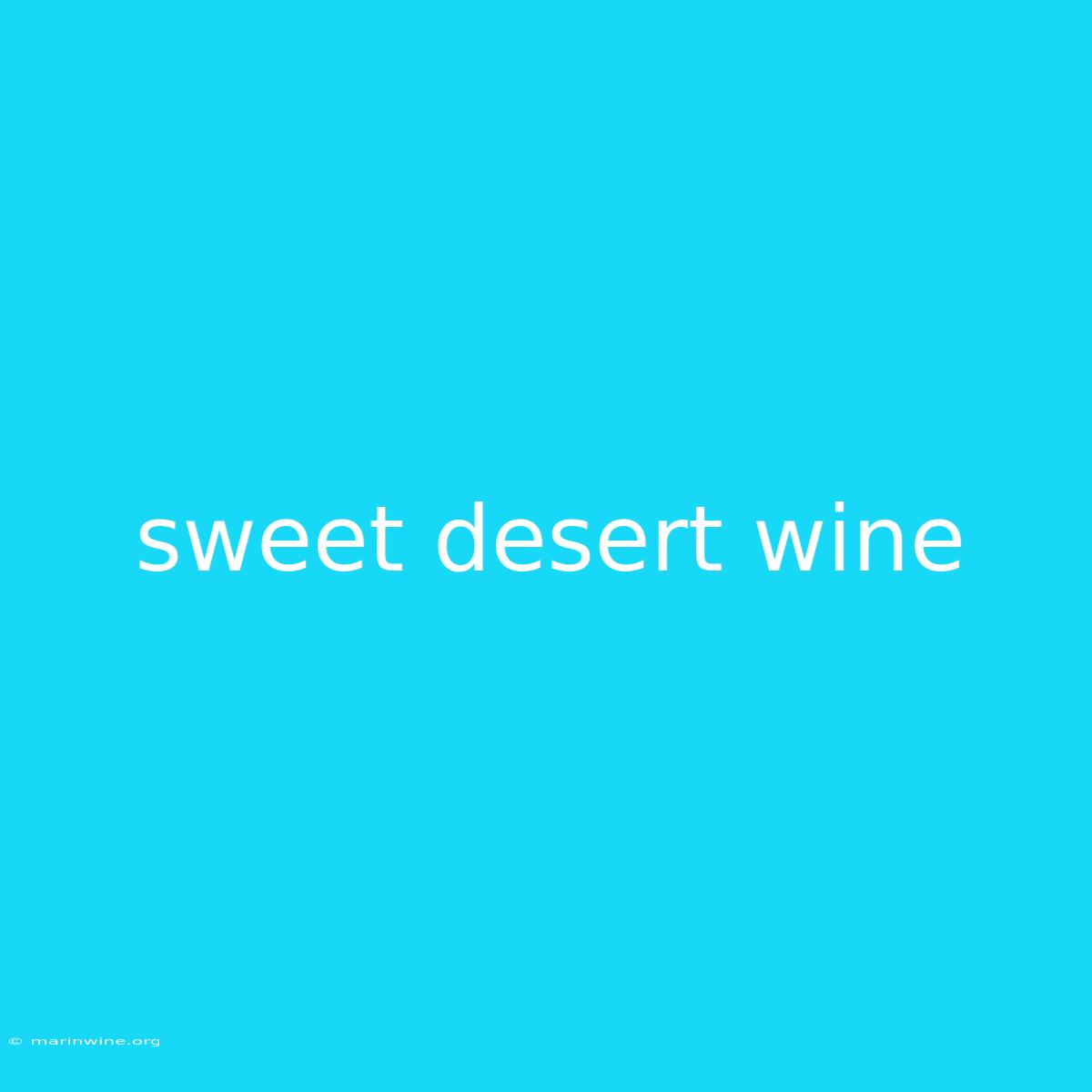Uncorking the Sweetness: A Dive into the World of Dessert Wines
Have you ever wondered why some wines are so intensely sweet, almost like a liquid dessert? This is the magic of dessert wines, a category brimming with diverse flavors and intriguing production methods. Let's explore this captivating world and uncover the secrets behind these luscious libations.
Why It Matters: Dessert wines are more than just sweet treats; they offer a unique journey of flavors and complexities, often pairing exceptionally well with decadent desserts, rich cheeses, and even spicy dishes. This article explores various types, production methods, and key factors to consider when venturing into the world of dessert wines.
Key Takeaways of Dessert Wines:
| Key Takeaway | Description |
|---|---|
| Naturally Sweet: Some dessert wines derive their sweetness from naturally high sugar levels in the grapes. | |
| Fortified: Other wines are fortified with alcohol, which stops fermentation and preserves residual sugar. | |
| Diverse Flavors: Expect a spectrum of flavors from honeyed sweetness to complex notes of dried fruit, spice, and even earthy tones. | |
| Perfect Pairings: These wines are exceptional partners for decadent desserts, rich cheeses, and even spicy cuisine. |
Exploring Dessert Wine: A Journey of Sweetness
Understanding the Nature of Sweetness: Dessert wines can be categorized into two broad types: naturally sweet and fortified wines.
Naturally Sweet Wines:
Introduction: These wines are produced from grapes with high natural sugar content, usually grown in warm climates.
Facets:
- Late Harvest: Grapes are left on the vine longer, allowing for greater sugar concentration and increased sweetness.
- Botrytis Cinerea: Also known as "noble rot," this beneficial fungus creates a unique flavor profile.
- Ice Wine: Grapes are harvested frozen, concentrating sugar and resulting in an intense sweetness.
Summary: Naturally sweet wines retain their inherent sweetness due to the grapes themselves, leading to a naturally balanced flavor profile.
Fortified Wines:
Introduction: These wines are characterized by the addition of alcohol during fermentation, stopping the process and leaving residual sugar.
Facets:
- Port: Fortified with grape brandy, offering a range of styles from ruby to tawny, with notes of fruit, spice, and chocolate.
- Sherry: A fortified wine from Spain, undergoing a unique aging process, resulting in complex flavors, including nutty, savory, and oxidized notes.
- Marsala: An Italian fortified wine, known for its nutty, caramel, and dried fruit flavors.
- Madeira: A fortified wine from Portugal, aged in oxidative conditions, offering a distinctive flavor profile of toffee, caramel, and dried fruit.
Summary: Fortified wines use alcohol to preserve sweetness, resulting in a richer, more complex flavor profile that often ages beautifully over time.
The Connection Between "Point" and "Dessert Wines"
This section will delve into a specific point related to dessert wines, providing in-depth analysis and examples.
- Point Example: Fortified wines are often associated with specific regions. Explore the unique characteristics of Port from the Douro Valley in Portugal, its distinct production methods, and how this impacts its final flavor.
Information Table: Key Dessert Wine Regions
| Region | Wine Type | Key Characteristics |
|---|---|---|
| Douro Valley, Portugal | Port | Ruby, tawny, vintage, and LBV styles with rich fruit, spice, and chocolate notes. |
| Jerez, Spain | Sherry | Fino, Amontillado, Oloroso, and PX styles with nutty, savory, and oxidized flavors. |
| Sicily, Italy | Marsala | Dry, semi-dry, and sweet styles with nutty, caramel, and dried fruit flavors. |
| Madeira, Portugal | Madeira | Dry, medium, and sweet styles with toffee, caramel, and dried fruit flavors. |
| Sauternes, France | Sauternes | Sweet and complex wines with honeyed sweetness, apricot, and citrus notes. |
| Tokaj, Hungary | Tokaji | Sweet and complex wines with honeyed sweetness, apricot, and citrus notes. |
FAQ for Dessert Wines:
Introduction: Let's address some common questions about dessert wines.
Questions:
- Q: How do I choose the right dessert wine for my meal?
- A: Consider the sweetness and complexity of the wine alongside the dishes you're serving.
- Q: How do I store dessert wines?
- A: Fortified wines can age beautifully, while naturally sweet wines are best enjoyed within a few years.
- Q: What temperature should I serve dessert wines?
- A: Most dessert wines are best enjoyed slightly chilled, between 45-55°F (7-13°C).
- Q: Can I drink dessert wines on their own?
- A: Absolutely! Many dessert wines are enjoyable to sip on their own, especially after a meal.
- Q: Are dessert wines expensive?
- A: Dessert wines range in price depending on the type, vintage, and region.
- Q: How do I learn more about dessert wines?
- A: Explore online resources, attend wine tastings, and read articles from knowledgeable wine experts.
Summary: The FAQ section highlights practical information and addresses common concerns about dessert wines.
Tips by Dessert Wines
Introduction: Here are some tips to enhance your experience with dessert wines:
Tips:
- Experiment: Explore different types of dessert wines to discover your preferences.
- Pair wisely: Consider pairing dessert wines with rich desserts, cheeses, or even spicy dishes.
- Serve chilled: Most dessert wines are best served slightly chilled.
- Use a small glass: Use a small glass to focus the aromas and flavors of the wine.
- Take small sips: Savor each sip and allow the flavors to develop on your palate.
- Enjoy the experience: Dessert wines are meant to be enjoyed, so relax and savor the flavors.
Summary: These tips provide practical advice for enjoying dessert wines to the fullest.
Summary by Dessert Wines
This article explores the fascinating world of dessert wines, delving into the nuances of sweetness, production methods, and key characteristics. We've explored both naturally sweet and fortified wines, highlighting regional variations and ideal pairings.
Closing Message: Venture beyond the familiar and explore the unique world of dessert wines. Discover the captivating flavors, embrace the unexpected pairings, and appreciate the art of these liquid desserts.

